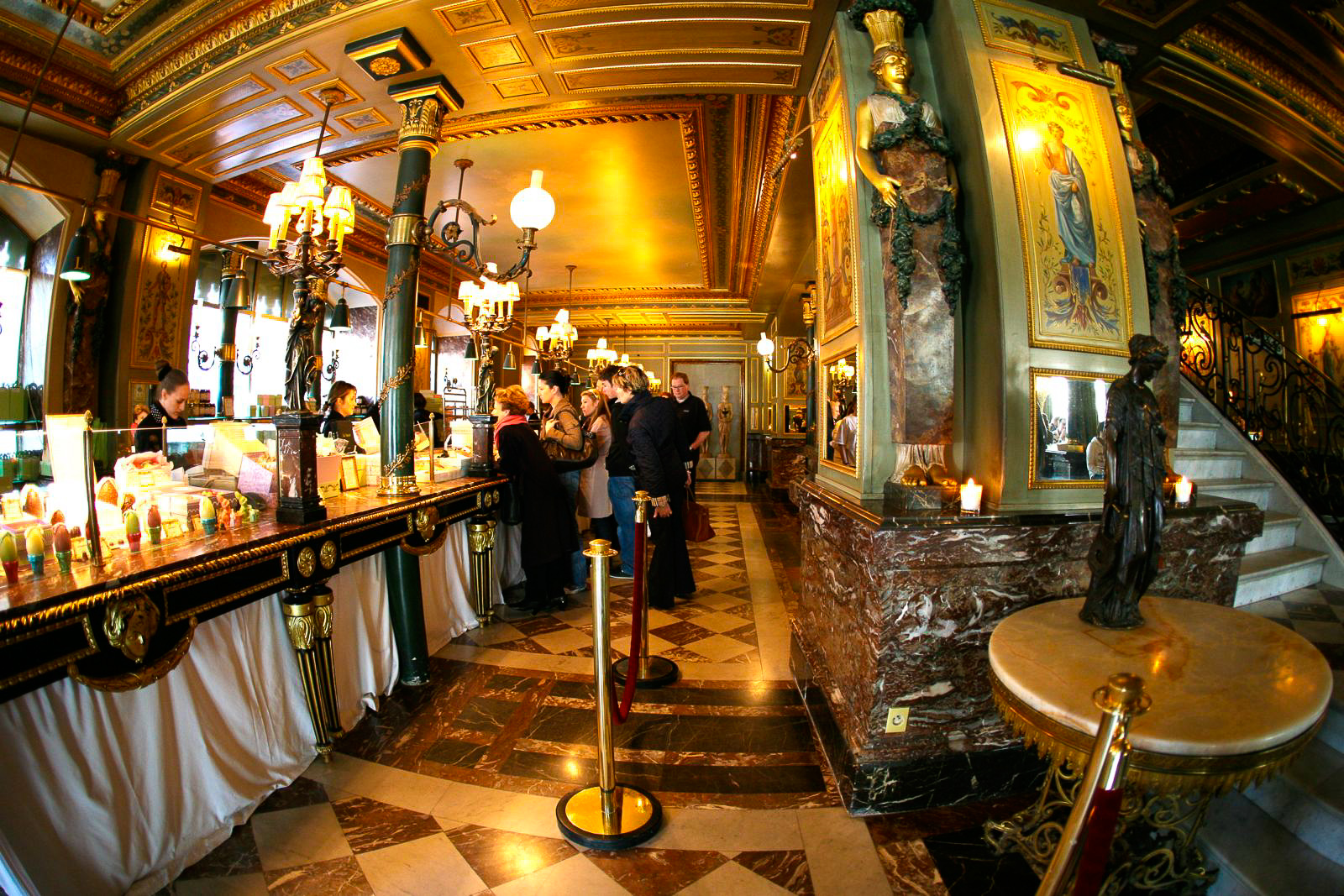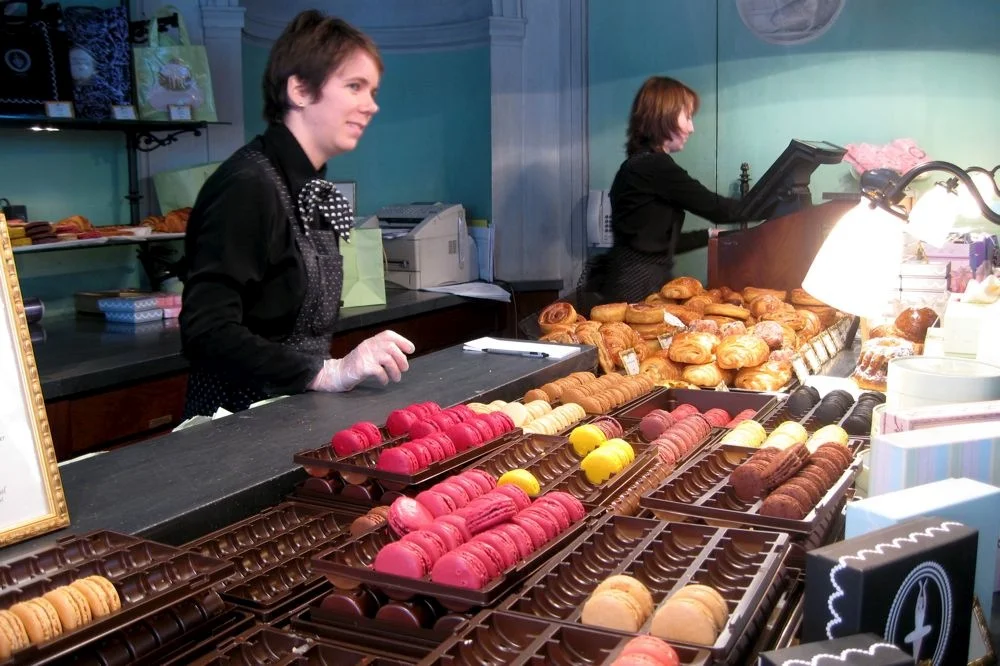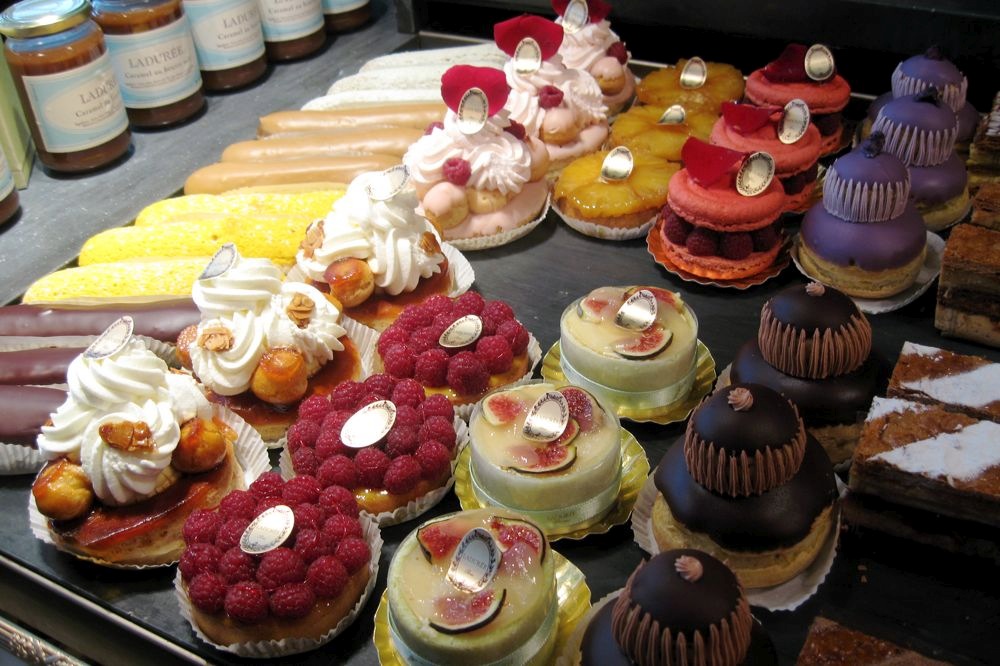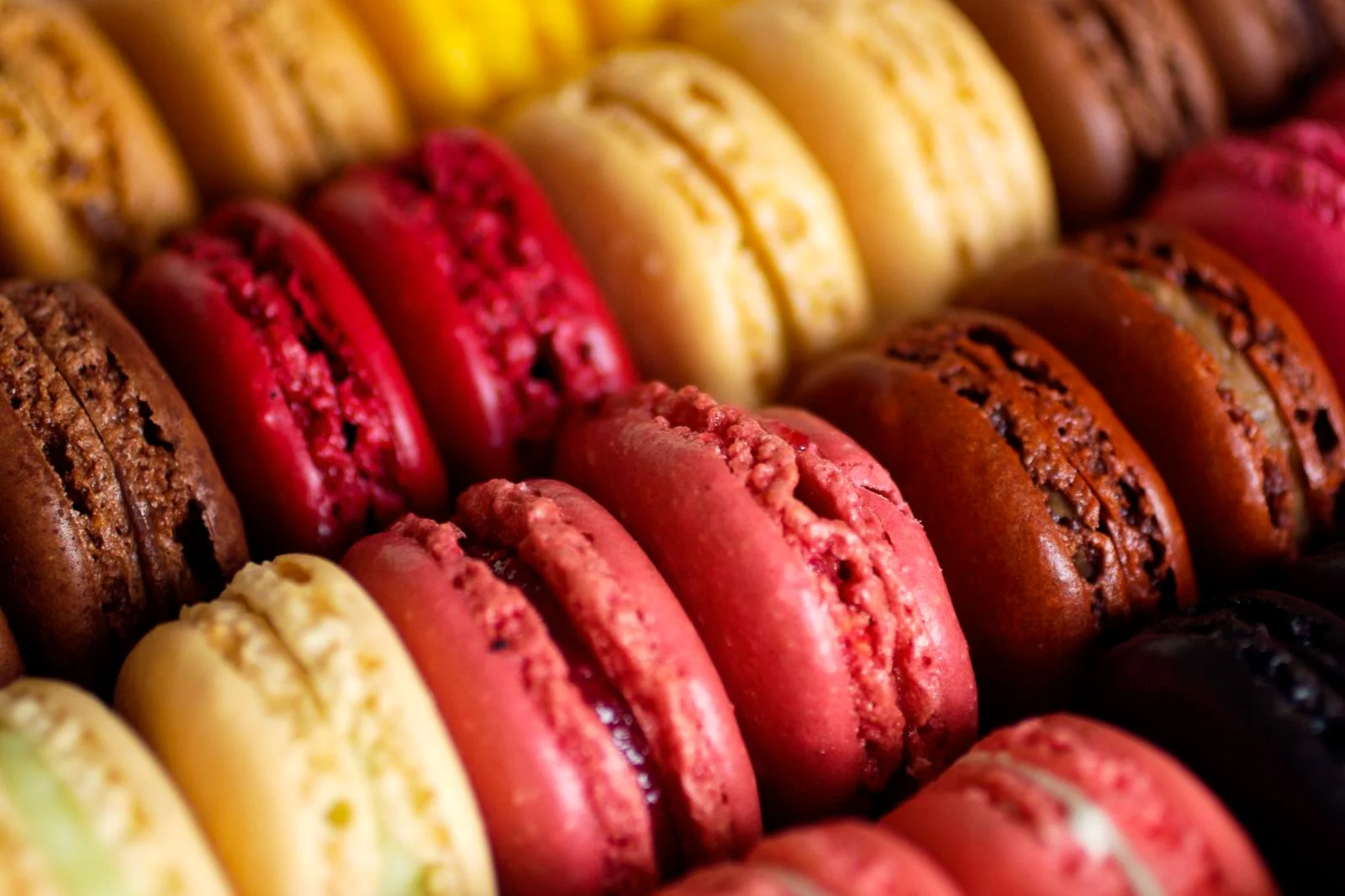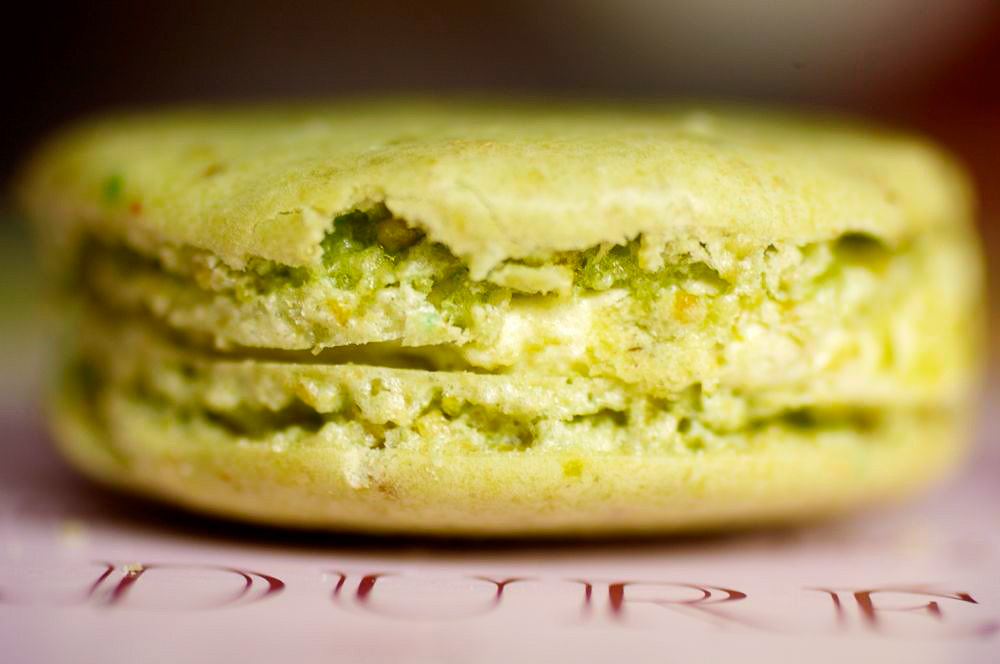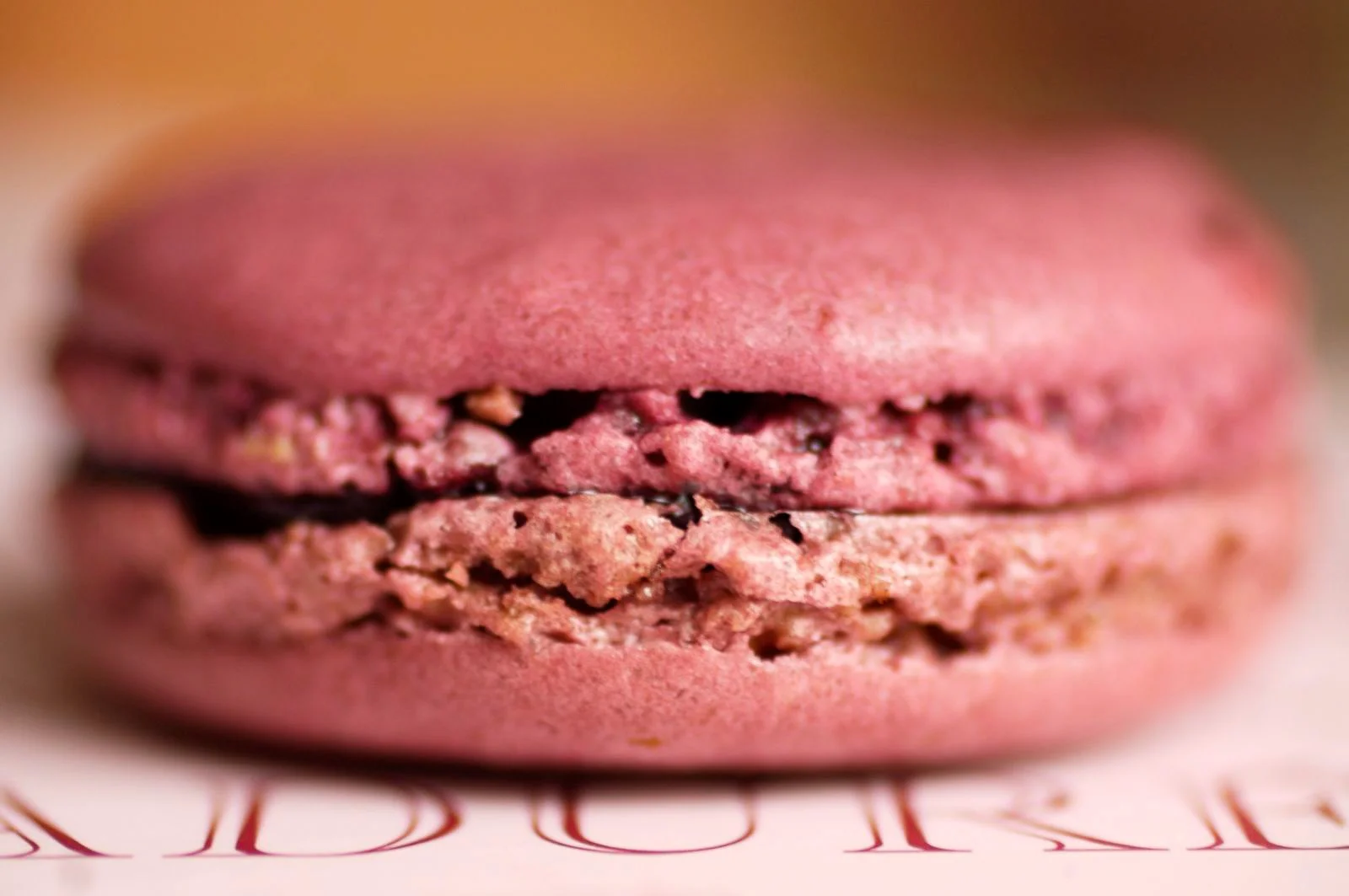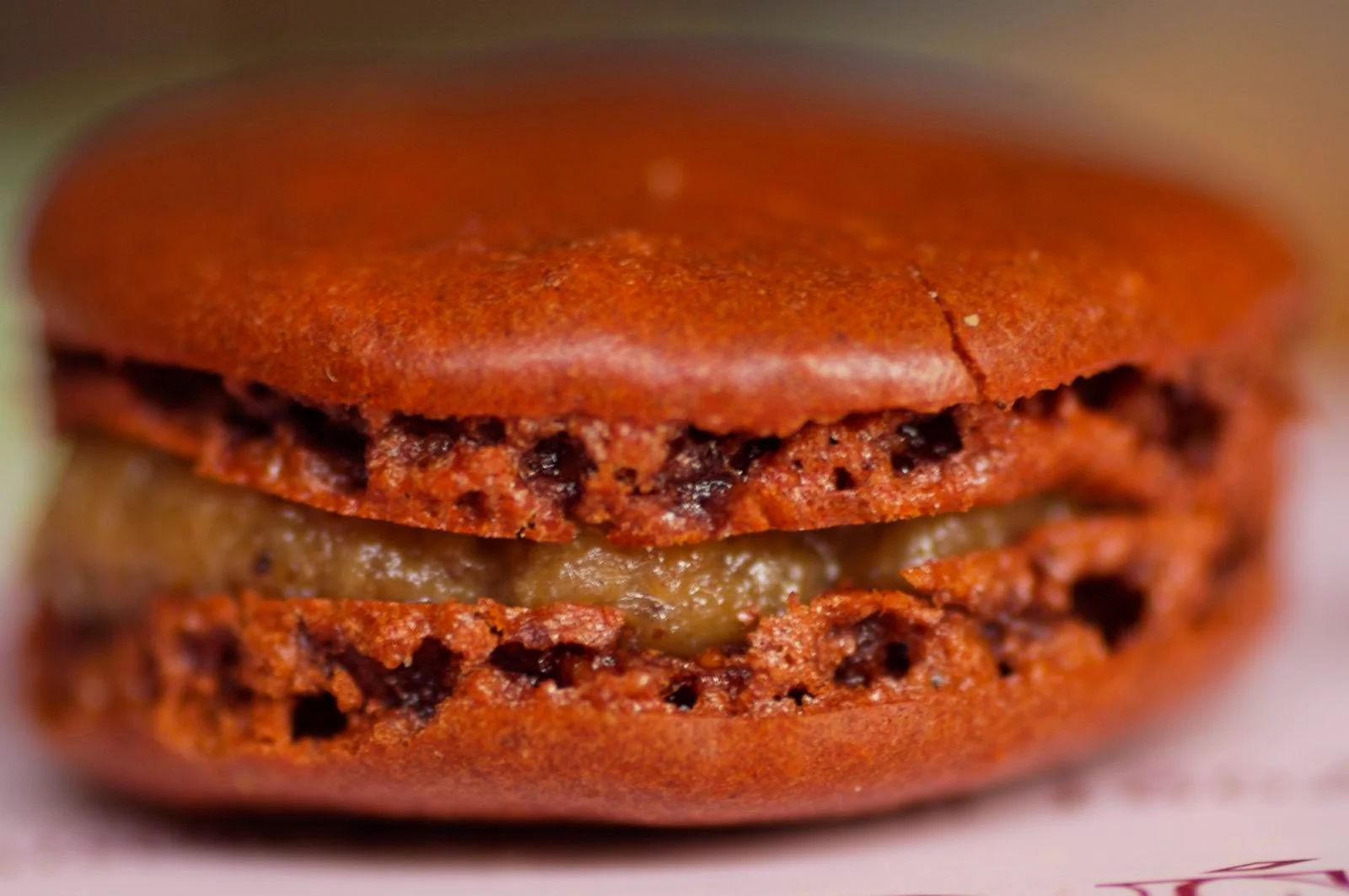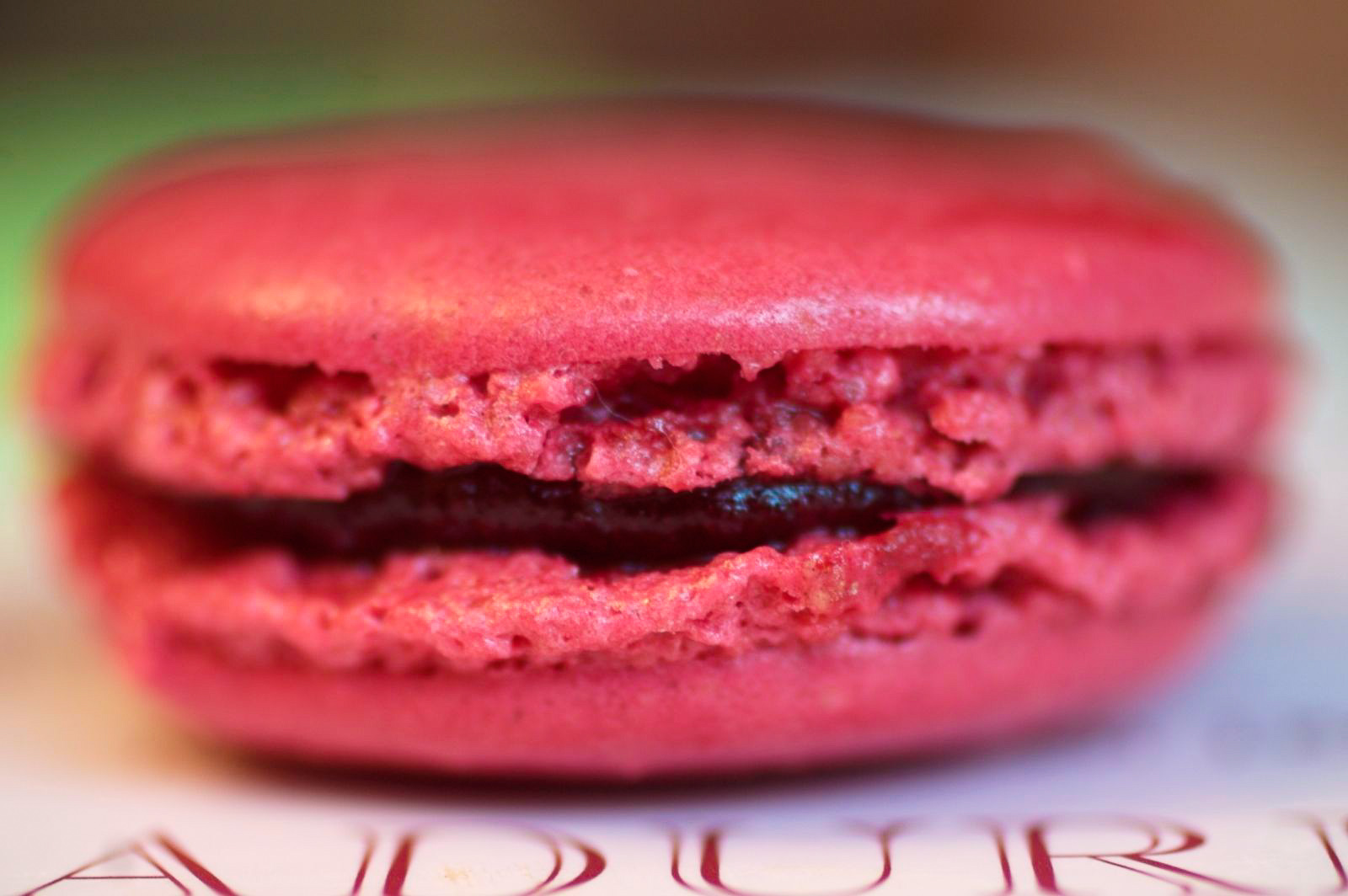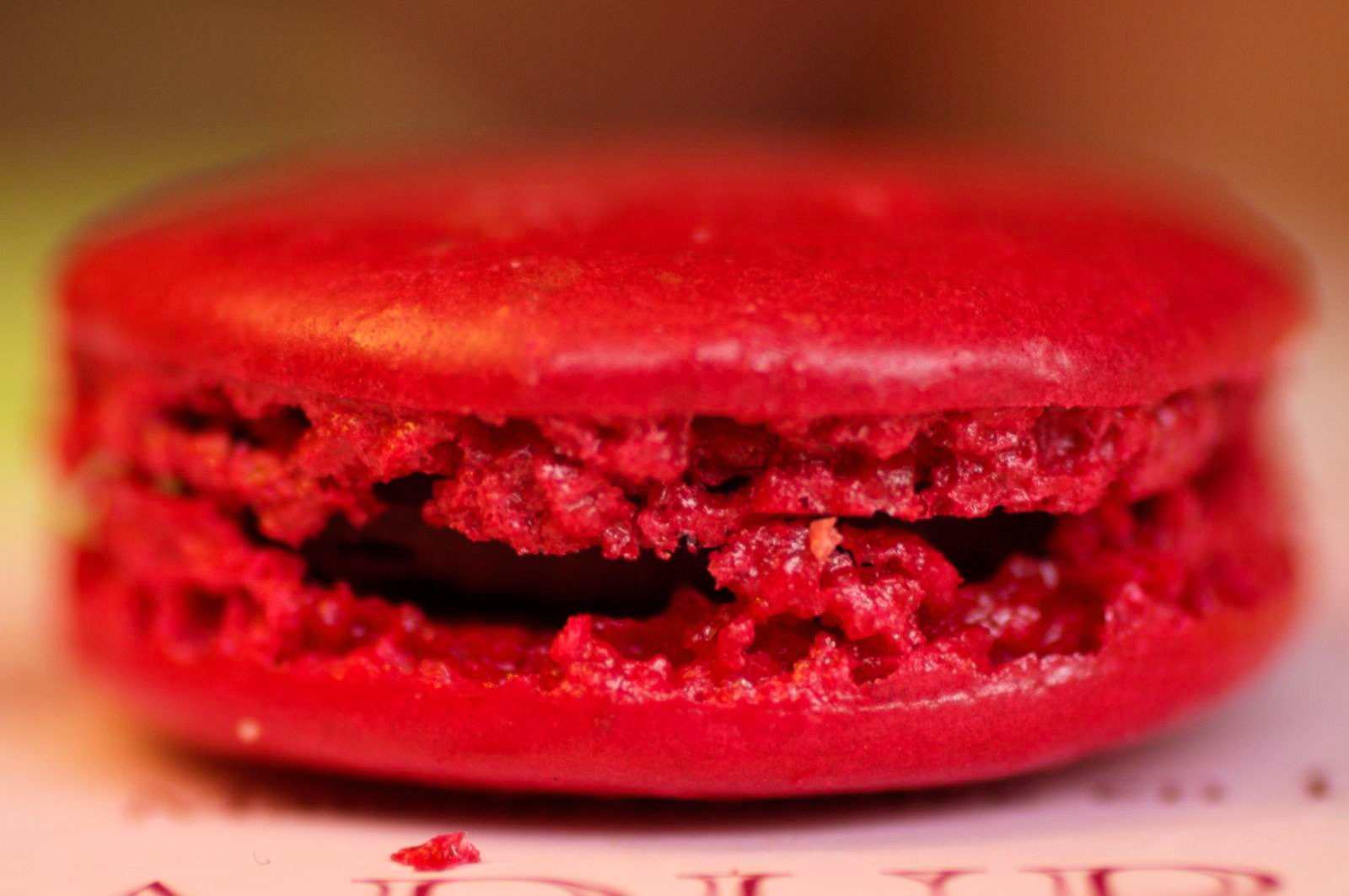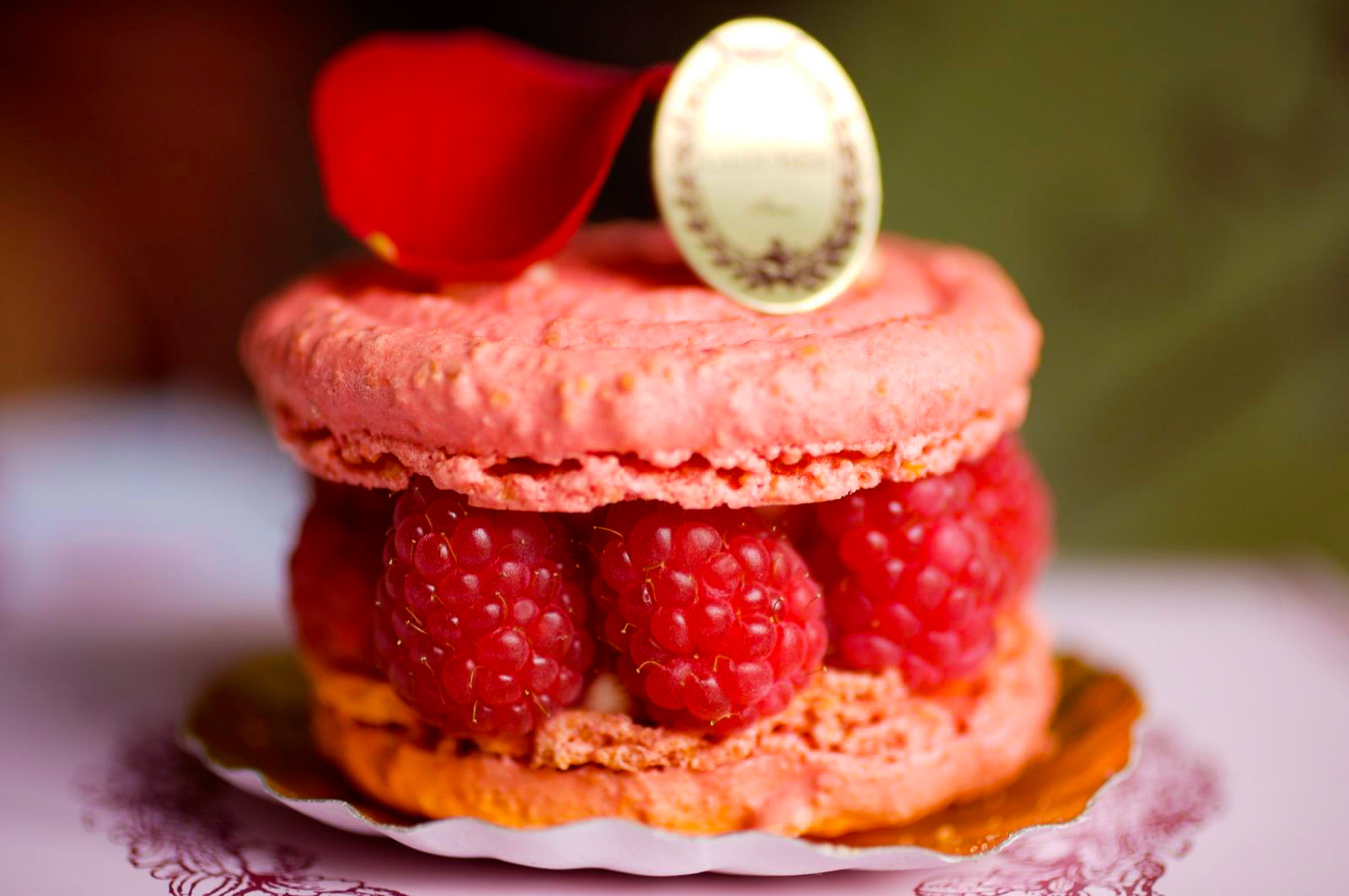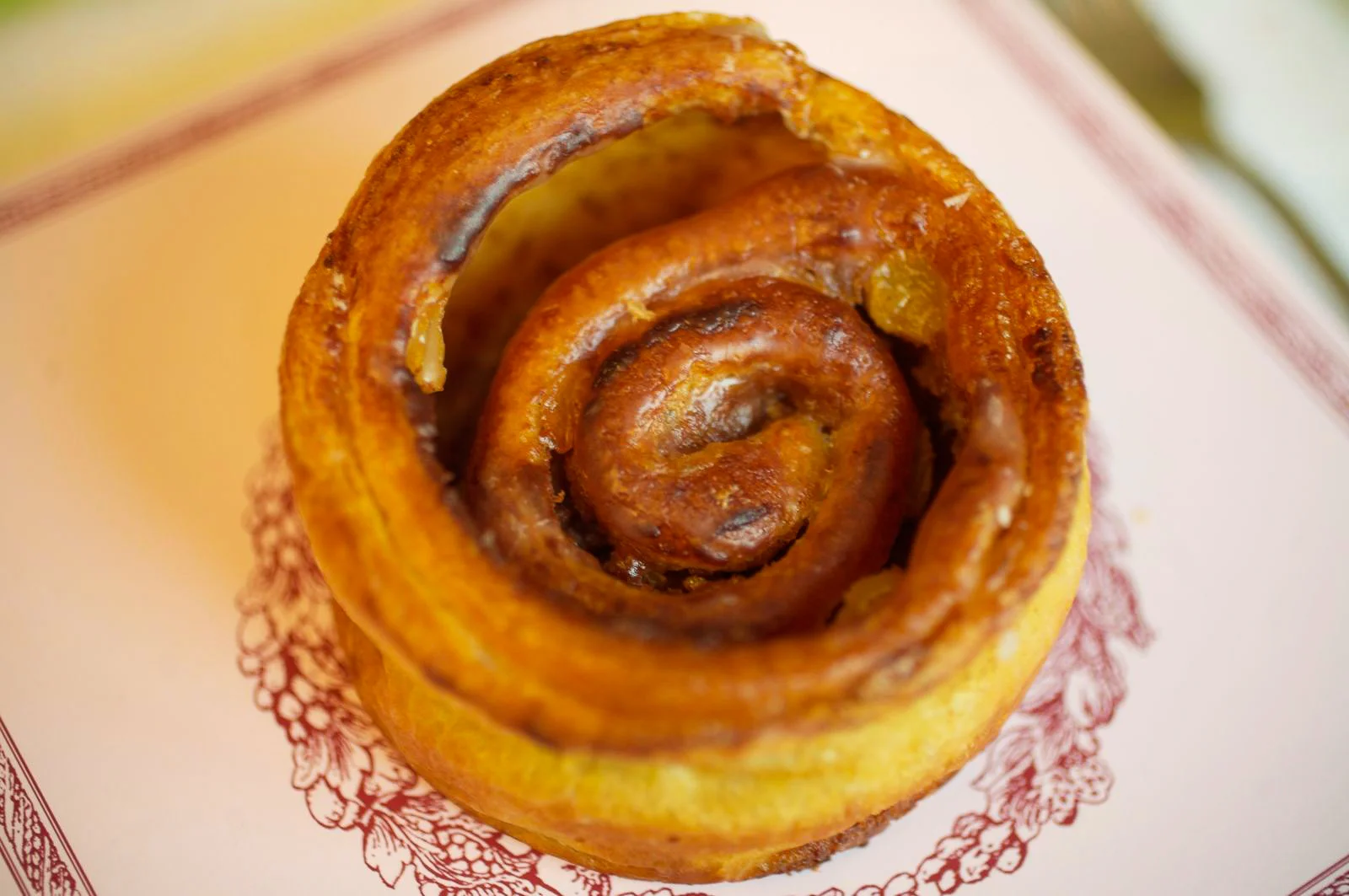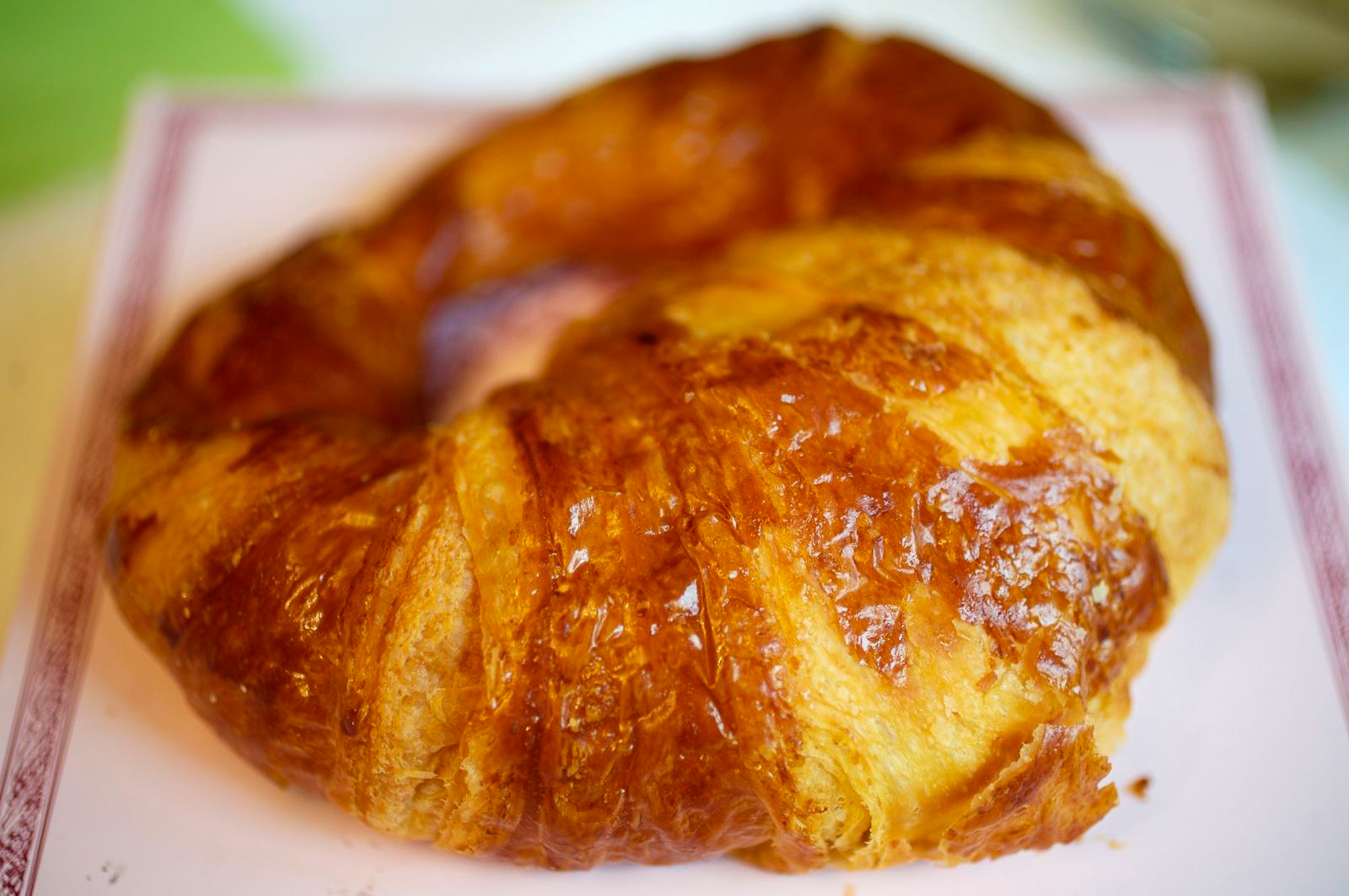Ladurée
When it comes to tea, England and Japan regularly garner much of the world’s international attention. But to France’s credit, that doesn’t mean that tea cannot be enjoyed in Paris. Perhaps due to its role as a trading hub for Europe, or possibly because of its close proximity to England, Paris does indeed have a handful of tea salons, the most famous of which being Ladurée, which has been around for over 150 years. There is certainly a bit of pretense within the sit-down dining room full of mother-daughter tea parties and power business lunches, which is why I would recommend getting things to go. But that being said, the real specialty of this tea establishment is the Ladurée macaron, a heavenly pastry for which I have fallen head over heels.
I stood in a brief line at the St. Germain Ladurée amongst my hungry international peers, each waiting to bring home a box of happiness in the form of miniature cookies. There was a very impressive selection of macarons, over seventeen flavors, in fact. In addition to the macarons were rows of colorful tartes and tempting butter-striped pastries. Decisions, decisions. Thankfully, there were several people in front of me and I had time to mentally choose a few of my favorite treats before being served. There was no tasting menu, or any other socially acceptable excuse for satisfying my hunger, so I decided to create my own tasting: two of every macaron, three tartes, a millefeuille, two croissants, and a cannelé. Indeed, I kept it light this time. I decided to take the long way home, carrying my bag in both arms, fearing that the crowds of people on the main street would threaten the textural safety of my delicate delights.
I started with the rose macaron, two rose-colored halves of meringue contrasting against the pure white middle layer. The ganache had an ultra-light texture of whipped cream, making this the lightest macaron I’ve ever lifted. Despite this cookie’s floral flavor, there was no soapiness whatsoever – only a delicate flavor of the scent of rose. Sweet, indeed; but the airiness of the ganache prevented any cloying repercussions. This cookie brought a smile to my face after the first bite, the bright white ganache of the second bite smirking right back at me. What a pleasant way to begin.
Next was the staple pistache, a flavor that rests just in-between one-time inventiveness and daily satisfaction: I’m always in the mood for pistachio macarons. The color was just amid green and brown, hinting at natural pistachio color rather than the commercialized bright green notion of what that color should be. This cookie was only slightly heavier than the rose, perhaps due to the presence of small chips of actual pistachio nut. The ganache was still fluffy, a word that does not seem to exist in the world of Pierre Hermé. The flavor was strikingly similar to the ground pistachio nut, with a small hint of dulce de leche on the aftertaste. There was also a slight mention of salt, which made sure the sweetness would stay within reign. I could eat a lot of these.
Since my first two cookies were stunning, I wanted to follow it up with a flavor I have always hated, just for comparison. It came down to coffee and licorice, the latter of which winning because of its jet-black color and golden-green filling. Sit down for a second, please; because what I'm about to suggest might sound alarming. Ladurée’s licorice macaron is the single most delectable macaron I have ever tasted. I know how it sounds. "But licorice?!" I was a bit startled myself; so much so, in fact, that I later returned and tried a large box of only licorice macarons for confirmation. Confirmed. This flavor is special is because it tastes more like chestnut or almond than licorice, while still maintaining the winter cool fresh aftertaste of licorice. The cookie also smells like licorice. A strange discovery indeed; but, this was hands down delicious. A must for trying, in my book.
It seemed that intuition had been failing me, and I decided to randomly pick the next flavor: pain d’épice. This seasonal gingerbread macaron indeed smells like gingerbread cookies, quickly bringing to mind holiday imagery of turkeys, gravy, cranberry sauce, apple pie, pumpkin, chestnuts, egg nog, stuffing, sweet potatoes pine trees and snow. Unlike gingerbread cookies, however, this macaron left a tingling trail of spiciness, a clue that real ginger was in fact involved. This cookie was not too sweet at all, a characteristic I find pretty frequently in other gingerbread macarons. Also, for some reason, this was the softest of the macarons: I had to use two hands to take it out of the box as the meringue halves were sliding around – a clear sign of extreme freshness.
Praliné was next, and by the specks of brown in the tan colored cookie, I knew this was going to be good. And it was, having a slightly grainy texture – another reminder of the use of actual pralines. The creme center was slightly dense, like a chantilly; but, by no means heavy. It was a little pasty, in fact. For some reason, after finishing this cookie, the only taste left in my mouth was that of fresh pralines -- as if I had just taken a handful of the raw nuts and eaten them. Nice.
Next up was citron, a brilliant lemon colored yellow that made me wonder what would happen if I took out my blacklight. The coloring was a little exaggerated, and certainly artificial; but the bright flavor of this treat quickly put appearances aside. The flavor was actually a bit sour; but the airiness of the ganache with the sweetness of the meringue made it less offensive. I probably wouldn't order this macaron by itself; but, it served well as a palate cleanser midway between this extensive cookie tasting.
Continuing with the theme of fruit, framboise was the next victim. The ganache was more like raspberry preserve as in, certainly not airy. The raspberry seeds were left in which made for occasional bursts of texture as well as flavor. I thought this macaron was a little too sweet, the flavor being overwhelmed by the jelly-like consistency of the center. I've never seen a cream-based raspberry ganache; but that might be a nice alternative -- particularly to make the inside texture lighter and less cloying. That being said, the freshness of this macaron caused it to literally fall apart as I began eating it, the top and bottom halves sliding around between my thumb and index fingers with a single bite for each bite.
Cassis was next, a fruit that, in France, is oddly ubiquitous alongside strawberries and raspberries. The color was a provocative purple, one that clearly stood out among the rest of the colors while not appearing artificial. The flavor was very tart. This was pretty similar to the framboise in that the filling was just too cloying from its preserve-consistency. The flavor was a little too sour and acidic for me, similar to eating a handful of raw cranberries.
I soon realized that it was time to take a break from fruit, and I headed in the opposite direction: chocolate. Ladurée offers two flavors of chocolate, chocolat and chocolat amer (bitter chocolate). I started with chocolat -- a macaron that seemed as if someone had secretly snuck a chocolate brownie in between my layers of meringue ... too dense! It was a workout even to lift it up, certainly the heaviest of the selection. The flavor was nicely balanced: a blend of sweet cocoa with a touch of salt, a combination that goes very nicely, I thought.
Following the chocolat was chocolat amer, the bitter chocolate version. At first, it was a little challenging to identify the exact differences between these two flavors; but, by the third macaron, they became apparent. The bitter chocolate macaron was much lighter with the ganache having a texture a bit thicker than heavily whipped cream. This macaron was also noticeably less sweet, which would be expected. I'm not sure that I would order any of the chocolate macarons on their own again, mostly because I'm not chocolate-crazed; but if I had to choose between the two ... bitter chocolate would be it. It won both texturally, and in terms of flavor.
Fruits rouges was next, a blend of red fruits that was strangely similar to framboise without the seeds with what tasted like a splash of shirley temple (grenadine). If macarons had siblings, this would be the little sister of framboise -- most of the flavor with the slight textural difference of being seedless. This was also not sour at all, and was much brighter than the framboise. The texture was jelly-based; but there was such a thin spread, and since there was no tartness, it did not become cloying.
Vanille. Wow. This was, frankly, incredible. Before eating this light cream-colored treat, the first thing that struck me about it were the hundreds of tiny black specks of vanilla beans throughout. That's always a good sign as it indicates the full vanilla flavor will matriculate, rather than tease. The ganache center was a little heavier than some of the other vanilla macarons I've tasted, with a texture somewhat similar to room temperature butter. But this was not at all a bad thing because it provided a sturdy vehicle to carry the rich flavors. The only flaw I can come up with was that some might find this a little too sweet -- I did not. Delicious.
I eagerly await the day I enjoy coffee flavored desserts and pastries; because, this certainly was not it. This cafe macaron, indeed tasted like coffee and indeed, I did not like it. The flavor reminded me of the bottom of a poorly stirred cappuccino with sugar -- very sweet, almost bearable; but still, coffee. The texture was pleasant though, a spongy grey-brown cream with a slight graininess. The macaron smelled like the real thing -- in fact, it scented my entire box of macarons with the smell of coffee beans. At the end of the day, I'm sure there will be people who enjoy this. It just wasn't for me.
Something about salt and caramel goes together really nicely, and this was certainly the case with my next macaron, caramel au beurre salé, a beautiful marriage of the sweetness of sugar and butter tempered, and made more complex, by the addition of salt. The inside was sticky, similar to dulce de leche, which means that this must be eaten at room temperature or the inside will be too hard. Perhaps I would have liked a little more of a burnt caramel flavor; but I was impressed that this was not cloying.
I was intrigued by what seemed to be a vanilla macaron without the vanilla beans from above; but, contained a light green filling. It smelled a bit of citrus; but certainly not lemon or orange. After giving up on the flavor game, I glanced at the cheat sheet and discovered it to be Fleur d'Oranger, or orange blossom, the product of orange tree leaves producing something very similar to a citrus-scented rosewater. The texture of this ganache was like a light custard -- light; but not quite whipped. There was no acidity or sourness at all, and while I wouldn't necessarily say this had a bright flavor, it was sweet -- almost like candied orange rind. It was interesting to try this flavor; but, I'm not too sure I'd go for it a second time ... though I certainly would not complain.
Rouge Diva was certainly interesting, a mix of red fruits and gingerbread with the scent of chocolate. To me, this seemed to be trying to do too much at once, particularly because I thought the chocolate scent polluted the warm flavor of gingerbread with the candied sweetness of the fruit. The texture of the ganache was too dense and a bit pasty, which I suspect was due to the presence of chocolate. There was also a slightly carbonated flavor -- hard to pinpoint the source, though I'm tempted to blame all things bad about this macaron on the chocolate.
And that sums up the macarons; oh wait, we have two hybrid macaron-tarte varities. Having been thoroughly impressed by what I believe to be Pierre Hermé's most expressive creation, the Ispahan, I had high expectations here at Ladurée. But while Ladurée's Ispahan was a worthy competitor, it did not stand up to its competition down the street at Pierre Hermé. Aside from the subtle differences, such the lack of a sugar dew droplet and the wonderfully fragrant scent of rose, Ladurée's creation hid the presence of lychee with an overwhelming amount of sugar in the creme center. The macaron component was also a little dry, likely a factor of the tarte having been produced the day before. The presence of rose was also somewhat a secret, something I would have liked to be more conspicuous. Definitely a beautiful creation; it just lacked a bit of luster.
Next up was the Charlotte poire et figue, a pear custard tarte topped with slices of fresh fig. I admit, I selected this because of the presence of figs; but was ultimately disappointed. First, the figs lacked sweetness of any kind. While this might have been due to their off-seasonality, I would have liked to see them a little sweeter -- a bit of sugar would have gone a long way. As for the rest of this creation, the texture got boring very quickly -- it was a monotonous custard from top to bottom with a soft sponge base. Something crispy, perhaps a light tuile, would have been a nice contrast. I also found the flavor too light on the sugar, which became particularly evident since the figs were not candied. After eating this, I took another look at the title which reminded me that this contained pears. Aside from the light green color, where were they? I completely forgot they were included.
I was starting to get a little full, so I took a brief break to get a glass of water and a wedge of bleu d'auvergne. When I came back, the thought of fresh fruit seemed really appealing, directing my stomach towards the macaron pommes caramel, a caramel macaron with slices of baked apple. Unlike the caramel au beurre salé macaron, the flavor of this caramel had a burnt essence, adding a beautiful dimension of flavor to the sweetness of the caramel. The combination of apple and caramel reminded me of a candied apple, with two pieces of macaron so my fingers wouldn't get all sticky. As a textural contrast, hardened caramel was placed on top adding a crispiness to each bite. This was nicely balanced, both in terms of flavor and texture. While I thought this was the best of the tartes, my only complaint might be the excessive size of the apple slices -- the water component of the fruit absorbed a lot of the concentrated flavor of the caramel and meringue. While this did prevent the flavor from being cloying, I would have preferred that the task of temperament be left only to the salt -- half-sized or third-sized slices of apple would have done this well.
Last for the miniature tartes was the St. Honoré, a light puff pastry made heavy with caramel and topped with chantilly. Unfortunately, this has an incredibly short shelf-life. By the time I ate it, about 30 minutes later, the pastry had already started to become soggy. The caramel acted as a water-proofing seal against the chantilly; but the pâte à choux was attacked by the inconsistency of the caramel -- some parts were runny, others were crispy. This would normally suggest improper storage; but considering I walked home in the cold and ate it immediately after, it likely wasn't a problem on my end. I was pleasantly surprised when I bit into one of the three small pastry spheres resting on top, each of which was filled with vanilla custard. There was a slight salt and burnt caramel essence, making this flavor nicely balanced; but, I found its textural faults too distracting. I'd like to try this again, at some point.
Oh yes, the millefeuille praliné. Aside from the obvious macarons, I think it warrants a special trip to try this layered cake. Salt, burnt caramel, spongy nut-flavored creme, crispy sheets of pastry -- this treat had it all. It was so light and delicate! Thin sheets of chocolate were replaced with praline, a much better alternative. I very, very briefly thought about sharing this with my host family; but, turned that idea down after realizing it would be impossible to divide. Too bad. Despite being at room temperature, the cool creme filling made this pastry feel even lighter than its already apparent weightlessness. Little crisps of caramel, salt, and hardened pastry were scattered throughout -- keeping my interest with every bite. Awesome.
Strangely labeled a cannelé, this was more like a cinnamon bun with raisins then a caramelized bread pudding. But names aside, this would be a pleasantly moist and tasty way to begin a day with a cup of coffee. The cinnamon flavor was strong, and complimented the sweetness of the raisins and sugar. Despite being loosely rolled which, increases the surface area and exposure to air, this pastry was not dry at all. I didn't find this to be anything particularly special, perhaps because it was overcast by the strength of Ladurée's other delicacies.
Next up was a startlingly large butter croissant with which the butter stripes became apparent after the significant expansion in the oven. I'm not sure why this croissant was so large; I'm pretty sure it had double the calories nutritional contents of other croissants. While it wasn't greasy or oily, the inside was very dry making it difficult for me to place it on a level playing field for comparison.
The highlight of the croissants, however, was the pain au chocolate amande, which is the most impressive chocolate almond croissant I've ever tasted. To start, the almond filling contained morsels of almond, making for a really nice texture. The chocolate was an ultra-thin strip adding a touch of bitterness to the almond without being distracting or dominating. Together, these two fillings tasted very fresh. The croissant itself was light, and despite having a thin strip of filling, I was still able to pull out pieces of the center with my two fingers -- something I have never been able to do with any other chocolate almond croissant. It's safe to say that I will be waking up early one morning, with the ambitious hope of trying one of these hot.
It is now clear to me that Ladurée has the best macarons in the world. Aside from an impressive selection of flavors, most of the cookies are texturally flawless obeying the perfect ratio of ganache to meringue. And while Ladurée did have some experimental flavors, such as pain d'épice and rouge diva, they still remained true to the simple flavors such as pistache, vanille, and chocolat. After sampling both places, I learned of the rumor that when Pierre Hermé left Ladurée he took with him his recipe for Ispahan, which confirmed my strong opinion that Pierre Hermé is clearly the leader when it comes to this tarte. However, in terms of macarons, it was perhaps a good thing as everything Pierre Hermé does wrong with its petits gâteaux, Ladurée does right. I think that Pierre Hermé gets the macaron attention that it does because of the innovativeness of its flavors -- which are certainly innovative -- they're just held down by the heaviness and excessive cloying quality of their ganache. That being said, I would take the texturally perfect but simple elegance of Ladurée's vanilla or licorice macaron to any of Pierre Hermé's creative flavors, at any time.
And in addition to the macarons, let's not forget about the millefeuille and chocolate almond croissant which were also spectacular -- the millefeuille having a flaky yet creamy texture with a beautiful flavor contrast of salt, praline, and caramel, while the chocolate almond croissant tasted so fresh, genuine, and true-to-description that I was actually taken aback. For anyone on a macaron mecca to Paris, this is an absolute must-stop and, despite prejudices, try the licorice please, and don't neglect the millefeuille. And for those who pooh-pooh Ladurée's macarons in favor of the shiny new ones of Pierre Hermé these people are crazy I see where this opinion comes from, and I respect it -- good luck with that, I'll be down the street.



